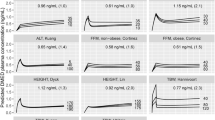Summary
The absorption and distribution of a single bolus of sufentanil 150µg for abdominal surgery were studied in 20 patients randomly injected either intravenously or intrathecally. Samples of plasma and cerebrospinal fluid (CSF) were taken at regular intervals from time zero to 180 minutes after injection and at the time of tracheal extubation. Sufentanil was analysed by radioimmunoassay. The plasma sufentanil concentration (Cp) after intravenous injection was significantly higher during the first 30 minutes than after intrathecal administration. The Cp at 180 minutes after intrathecal sufentanil injection was higher than after intravenous administration. The fraction of sufentanil that reached the central circulation at the time of tracheal extubation following intrathecal administration was 78%. In the intravenous group, sufentanil could be found in the CSF in only 3 patients, suggesting that the analgesic effect in this group is produced mostly by the supraspinal distribution of sufentanil. After intrathecal administration, sufentanil reached the systemic circulation rapidly and remained detectable for many hours. Owing to the physicochemical properties of sufentanil, the CSF compartment acts as a reservoir of sufentanil for a period shorter than is the case with intrathecal morphine. Sufentanil produces both surgical supraspinal and spinal analgesia after intrathecal injection.
Similar content being viewed by others
References
De Castro J, Meynadier J, Zenz M. Pharmacokinetics of opioids. In: De Castro J, Meynadier J, Zenz M, editors. Regional opioid analgesia; Developments in critical care medicine and anesthesiology. Vol. 20. Dordrecht, The Netherlands: Kluwer Academic Publishers, 1991: 51–83
Cousins MJ, Mather LE. Intrathecal and epidural administration of opioids. Anesthesiology 1984; 61: 276–310
Ionescu TI, Taverne RHT, Houweling PL, et al. A study of epidural morphine and sufentanil anaesthesia for abdominal aortic surgery. Acta Anaesthesiol Belg 1989; 40(1): 65–77
Ionescu TI, Taverne RHT, Houweling PL. Pharmacokinetic study of extradural and intrathecal sufentanil anaesthesia for major surgery. Br J Anaesth 1991; 66: 458–64
Norris MC, Arkoosh VA. Spinal opioid analgesia for labor. Int Anesthesiol Clin 1994; 32(2): 69–81
Wilhelm AJ, Dieleman HG. Epidural fentanyl and sufentanil for intra- and postoperative analgesia. A randomized, double-blind comparison. Pharm World Sci 1994; 16(1): 7–12
De-Leon-Casasola OA, Lema MJ. Epidural bupivacaine/sufentanil therapy for postoperative pain control in patients tolerant to opioid and unresponsive to epidural bupivacaine/morphine. Anesthesiology 1994; 80(2): 303–9
Gibaldi M, Perrier D. Pharmacokinetics, drugs and the pharmaceutical sciences. Vol. 15. 2nd ed. New York: Marcel Dekker Inc., 1982: 445–9
Rowland M, Tozer TN. Clinical pharmacokinetics, concepts and applications. Philadelphia: Lea and Febiger, 1980
Dunne A. JANA: A new iterative poly-exponential curve stripping program. Comput Methods Programs Biomed 1985; 20: 269–75
Metzler CM, Elfring GL, McEwen AJ. A user’s manual for NONLIN and associated programs. Kalamazoo: Upjohn Company, 1974
Ionescu TI, Drost RH, Roelofs JMM, et al. The pharmacokinetics of intradural morphine in major abdominal surgery. Clin Pharmacokinet 1988; 14: 178–86
Ionescu TI, Taverne RHT, Drost RH, et al. Epidural morphine anesthesia for abdominal aortic surgery-pharmacokinetics. Vol. 14 (3). Regional Anesthesia, May–June 1989: 107–14
LaDu BN, Mandel HG, Way EL. Fundamentals of drug metabolism and distribution. Baltimore: Williams & Williams, 1971: 76–83
Jacobson L. Intrathecal and extradural narcotics. In: Benedetti C, Chapman CR, Morrica G, editors. Advances in pain research and therapy. Vol. 7. New York: Raven Press, 1984: 199–236
Batson OV. The vertebral vein system. Am J Roentgenol 1957; 78: 195–212
Bissonnette B, Nebbia SP. Hypothermia during anesthesia. In: Levitt RC, Benumof JL, editors. Anesthesiology Clinics of North America. Vol. 12 (3). Philadelphia: Saunders, 1994: 409–24
Author information
Authors and Affiliations
Rights and permissions
About this article
Cite this article
Taverne, R.H.T., Ionescu, T.I. Comparative Pharmacokinetics of Intravenous and Intrathecal Sufentanil for Major Abdominal Surgery. Clin. Drug Invest. 9, 217–225 (1995). https://doi.org/10.2165/00044011-199509040-00006
Published:
Issue Date:
DOI: https://doi.org/10.2165/00044011-199509040-00006




